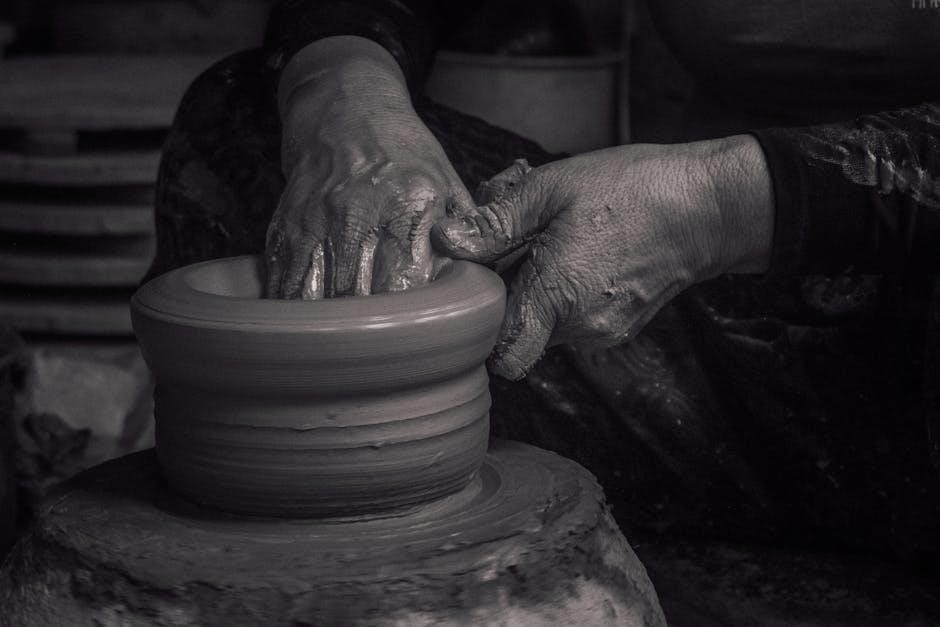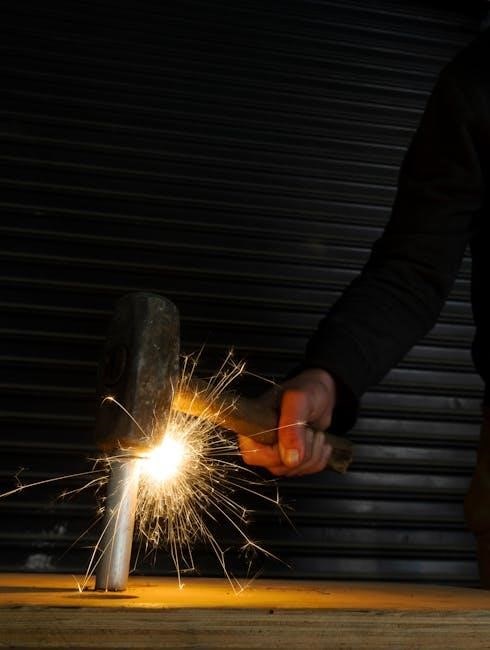Manual rod benders are essential tools for bending metal rods and flat stock, offering precision and control in various applications, from DIY projects to industrial tasks.
1.1 What is a Manual Rod Bender?
A manual rod bender is a tool designed to bend metal rods and flat bars with precision and control. It is typically constructed from durable materials like solid steel, ensuring longevity and strength. The tool features bending pins and a leverage mechanism, such as a handle, to facilitate easy bending. Manual rod benders are capable of bending rods up to specific diameters, such as 3/8 inch, and flat bars of varying widths. They are ideal for creating custom angles and shapes in metal stock, making them versatile for applications ranging from automotive repairs to DIY projects. Unlike hydraulic or pneumatic benders, manual rod benders rely on physical effort, offering a cost-effective and portable solution for bending needs.
1.2 Importance of Manual Rod Benders in Metalworking
Manual rod benders are indispensable tools in metalworking, offering versatility and efficiency for shaping metal rods and flat bars. They enable the creation of precise angles and custom shapes, essential for fabricating components in automotive, DIY, and industrial projects. Their portability and ease of use make them ideal for workshops, garages, and on-site tasks. Unlike hydraulic or pneumatic alternatives, manual rod benders are cost-effective and require minimal setup, making them accessible for small-scale operations. They are particularly valuable for bending smaller diameter rods and flat stock, providing control and accuracy that is difficult to achieve with larger machinery. Whether for professional metalworkers or hobbyists, manual rod benders are a practical solution for achieving high-quality results without the need for complex equipment.

Types of Manual Rod Benders
Manual rod benders come in various designs, catering to different metalworking needs. They include bench-mounted models for stability and portable options for versatility, ensuring precise control over bends.
2.1 Hydraulic vs. Manual Rod Benders
Hydraulic rod benders utilize fluid pressure to apply force, offering greater power and efficiency, especially for thick or hard materials. They are ideal for industrial-scale projects and heavy-duty applications. Manual rod benders, on the other hand, rely on physical effort, providing precise control and portability. These tools are cost-effective and suitable for smaller projects or DIY tasks. While hydraulic models excel in speed and capacity, manual benders are preferred for their simplicity and accessibility, making them a versatile choice for various metalworking needs.
2.2 Bench- Mounted vs. Portable Manual Rod Benders
2.2 Bench-Mounted vs. Portable Manual Rod Benders
Bench-mounted manual rod benders are designed for stability and precision, ideal for workshops or consistent use. They often feature sturdy frames and higher bending capacities, making them suitable for heavy-duty tasks. Portable manual rod benders, however, prioritize convenience and mobility, allowing users to work on-site or in tight spaces. These lightweight tools are easy to transport and require minimal setup. While bench-mounted models offer greater stability, portable benders provide flexibility, catering to different workflows and project requirements. Both options are effective for bending metal rods, but the choice depends on the user’s specific needs, such as workspace constraints or job location.

Applications of Manual Rod Benders
Manual rod benders are versatile tools for bending metal rods and flat stock, suitable for automotive repairs, DIY projects, and industrial tasks, offering precision and control.
3.1 Automotive Applications
Manual rod benders are indispensable in automotive applications for creating custom exhaust hangers, fabricating brackets, and shaping suspension components. Mechanics rely on these tools for precise bends in metal rods, ensuring durability and fitment. Whether crafting exhaust systems or repairing suspension parts, manual rod benders provide the necessary control to achieve accurate results. Their portability and versatility make them ideal for both professional garages and DIY enthusiasts, enabling efficient fabrication of metal parts essential for vehicle maintenance and modifications.
3.2 DIY and Hobbyist Projects
Manual rod benders are a favorite among DIY enthusiasts and hobbyists for crafting custom metal pieces. They enable the creation of unique items like decorative hooks, brackets, and furniture frames. Hobbyists use these tools to bend metal rods into intricate designs for art projects or functional items such as plant stands and coat racks. The ease of use and affordability of manual rod benders make them accessible to those who enjoy hands-on creativity. Whether it’s for home improvement or crafting unique gifts, these tools provide the flexibility and precision needed to bring imaginative projects to life, fostering creativity and self-expression in various DIY endeavors.
3.3 Industrial and Construction Uses
Manual rod benders are indispensable in industrial and construction settings for shaping metal components with precision. They are widely used for bending reinforcing bars, creating structural frameworks, and fabricating custom supports. In construction, these tools are essential for forming rebar into the required shapes for concrete reinforcement. For industrial applications, they are utilized to bend metal rods for machinery parts, shelving, and equipment repairs. The portability and durability of manual rod benders make them ideal for on-site use, enabling workers to achieve accurate bends efficiently. Whether for framing, installing utility hooks, or fabricating custom brackets, manual rod benders are versatile tools that support various industrial and construction projects, ensuring reliability and consistency in metalworking tasks.

Key Features of Manual Rod Benders
Manual rod benders feature robust constructions, precise bending pins, and ergonomic handles, ensuring durability, accuracy, and ease of use for various metalworking tasks and applications.
4.1 Bending Capacity and Diameter Limits
Manual rod benders are designed to handle specific bending capacities, typically accommodating round rods up to 3/8 inch and flat bars up to 1 inch wide. The bending pins, often 1/2 inch in diameter, ensure precise control and leverage for consistent results. These tools are suitable for materials like steel, aluminum, and copper, making them versatile for various projects. The capacity limits ensure safe operation, preventing material damage or tool overload. Choosing the right bender for your material size and type is crucial for achieving accurate and stress-free bends. Always check the manufacturer’s specifications to match the bender’s capacity with your project requirements.
4.2 Bending Pins and Leverage Mechanisms
Bending pins in manual rod benders are typically made of solid steel, with diameters ranging from 1/2 inch, ensuring durability and precise control during the bending process. These pins are designed to distribute pressure evenly, minimizing material deformation. Leverage mechanisms, such as long handles, amplify the user’s effort, making it easier to bend thicker or harder materials. The combination of robust pins and effective leverage allows for consistent, accurate bends in metal rods and flat bars. Proper alignment and use of these components are essential for achieving professional-quality results without damaging the tool or the material. Regular maintenance of these parts ensures optimal performance over time.
4.3 Ergonomic Design and Build Quality
Ergonomic design in manual rod benders enhances user comfort and efficiency, reducing fatigue during prolonged use. Handles are often designed for a secure grip, while balanced weight distribution improves control. Build quality is crucial, with tools typically constructed from solid steel for durability. This ensures long-term reliability and consistent performance. The ergonomic aspects, such as angled handles and smooth mechanisms, contribute to easier operation, allowing precise bends with minimal effort. High-quality materials and craftsmanship minimize wear and tear, making these tools a valuable investment for both professionals and hobbyists. A well-designed manual rod bender not only improves productivity but also enhances safety by reducing the risk of accidents caused by poor tool handling.

Choosing the Right Manual Rod Bender
Selecting the right manual rod bender involves considering bending capacity, material compatibility, and ergonomic design to ensure it meets your specific needs and enhances productivity and accuracy.
5.1 Factors to Consider When Selecting a Manual Rod Bender
When selecting a manual rod bender, consider the bending capacity, material type, and diameter limits. Ensure the tool can handle the required metal thickness and alloy, such as steel, aluminum, or copper. The design should offer ergonomic comfort and durability. Look for features like sturdy construction, bending pins, and leverage mechanisms that enhance precision and ease of use. Additionally, assess the tool’s portability and whether it suits your workspace, be it a bench-mounted or portable option. Proper alignment with your project needs ensures efficient and accurate bending, making the selection process crucial for optimal performance and long-term reliability.
5.2 Material Compatibility (Steel, Aluminum, Copper)
Manual rod benders are compatible with various metals, including steel, aluminum, and copper. Steel rods are commonly bent for structural applications, while aluminum offers lightweight flexibility. Copper, being softer, requires precise tools to avoid damage. The tool’s bending pins and mechanisms must align with the metal’s properties to ensure smooth, accurate bends without material stress. Proper material compatibility ensures efficiency and prevents damage during the bending process, making it essential to choose a bender suited for your specific metal type and application needs.

Safe Usage and Operating Tips
Always secure the rod firmly, use proper leverage, and ensure the bender is suitable for the material to avoid accidents and achieve precise bends safely.

6.1 Safety Precautions for Manual Rod Bending
Always secure the workpiece firmly to prevent movement during bending; Wear protective gloves and safety goggles to shield against sharp edges and potential debris. Use the correct tool size for the rod diameter to avoid overloading the bender. Ensure the material is compatible with the bender’s capacity to prevent damage or breakage. Never apply excessive force, as this can lead to accidents or tool malfunction. Keep loose clothing and long hair tied back to avoid entanglement. Avoid bending damaged or corroded rods, as they may fail under stress. Store the tool in a dry place to prevent rust. Regularly inspect the bender for wear and tear. Follow the manufacturer’s guidelines for optimal safety and performance. Proper precautions ensure safe and effective bending operations.
6.2 Best Practices for Achieving Accurate Bends
For precise bends, measure and mark the material accurately before bending. Use the correct bending pins for the rod diameter to ensure even pressure. Apply steady, controlled force to avoid over-bending or creating uneven angles. Test the tool on scrap material first to gauge the force required. Keep the workpiece aligned with the bending pins to maintain consistency. Use a protractor or angle guide to achieve the desired bend angle. Avoid bending near damaged or weak points in the rod. Lubricate moving parts if necessary to reduce friction and improve accuracy. Start with smaller bends and gradually adjust for larger angles. Always follow the manufacturer’s instructions for optimal results. Regular practice enhances skill and precision in achieving consistent, accurate bends.

Maintenance and Care
Regular cleaning and lubrication of moving parts ensure smooth operation. Store the tool in a dry place to prevent corrosion. Inspect for wear and tear periodically.
7.1 Cleaning and Lubrication of Moving Parts
Proper maintenance begins with regular cleaning of the tool’s moving parts. Use a cloth to wipe away dirt and grease, ensuring smooth operation. Lubricate hinges and pivot points with a high-quality machine oil to prevent rust and wear. Always inspect the bending pins and handles for any debris or corrosion. For tougher grime, a mild solvent can be applied, but avoid harsh chemicals that might damage the finish. After cleaning, apply a thin layer of rust-inhibiting oil to all metal surfaces. Regular lubrication ensures that the tool remains functional and extends its lifespan. Consistent maintenance routines will keep your manual rod bender in optimal working condition, ready for precise bending tasks.
7.2 Storage and Protection from Corrosion
When not in use, store your manual rod bender in a dry, cool place to prevent moisture exposure. Cover the tool with a protective cloth or plastic bag to shield it from dust. Apply a rust-inhibiting coating to all metal surfaces, especially after cleaning. For long-term storage, consider applying a layer of wax or silicone-based protectant. Avoid storing the tool in humid environments or near chemicals. If storing outdoors, use a weatherproof container. Proper storage ensures the tool remains corrosion-free and ready for use. Regularly inspect stored tools for signs of rust or damage. Taking these steps will extend the tool’s lifespan and maintain its performance over time.

Troubleshooting Common Issues
Troubleshooting manual rod benders involves identifying jams, alignment issues, or bent pins. Regular lubrication and inspection can prevent most problems, ensuring smooth operation and accuracy.
8.1 Addressing Bending Inaccuracy
Bending inaccuracy with manual rod benders often arises from improper alignment or worn-out bending pins. To address this, ensure the rod is centered and pins are tightly secured. Regularly inspect and replace worn components to maintain precision. Additionally, applying consistent leverage and using the correct die for the material diameter can significantly improve accuracy. If inaccuracies persist, check for misalignment in the tool’s frame or handle. Proper calibration and maintenance are key to achieving reliable, precise bends every time. Always refer to the manufacturer’s guidelines for specific troubleshooting steps to restore optimal performance.
8.2 Fixing Jammed or Stuck Components
Jammed or stuck components in manual rod benders can hinder productivity. To fix this, first, clean the tool thoroughly, removing any debris or metal shavings. Apply a high-quality lubricant to moving parts to reduce friction. If a component remains stuck, gently tap it with a mallet to loosen it. Avoid using excessive force, as it may damage the tool. Inspect for misalignment or bent pins, which can cause jams. Replace any worn or damaged parts immediately. Regular maintenance, such as lubricating hinges and checking pin alignment, can prevent future issues. Ensure all components are secure before use to maintain smooth operation and extend the tool’s lifespan.

Alternative Methods of Rod Bending
Beyond manual tools, alternatives include hydraulic and pneumatic machines for precise, heavy-duty bends, and heat-based methods for shaping metal without mechanical force, offering diverse solutions.
9.1 Hydraulic and Pneumatic Bending Machines
Hydraulic and pneumatic bending machines offer advanced alternatives to manual rod benders, providing greater precision and efficiency for heavy-duty applications. These machines utilize hydraulic cylinders and pumps to apply significant force, enabling consistent and accurate bends in metal rods. Pneumatic models, powered by compressed air, are ideal for high-speed operations. Both types are commonly used in industrial settings for bending steel, aluminum, and other materials. Hydraulic machines are particularly suited for large-diameter rods, while pneumatic systems excel in repetitive tasks. They often feature interchangeable dies, allowing for various bending radii and angles. These machines are widely adopted in automotive, construction, and manufacturing industries, offering superior performance compared to manual tools.
9.2 Using Heat for Bending Metal Rods
Using heat for bending metal rods is an alternative method that involves heating the metal to make it more pliable and easier to shape. This technique is particularly useful for bending harder metals like steel, which may be difficult to manipulate with manual tools. The process typically involves heating the rod in a controlled environment, such as a forge or with a torch, until it reaches a malleable state. The heated rod is then shaped using a jig or form to achieve the desired bend. While this method requires additional equipment and precautions, it allows for precise control over the bending process. However, it is less portable and more time-consuming compared to manual rod benders. Heat bending is often used in industrial and custom fabrication projects where specific angles and shapes are required. Proper safety measures, such as protective gear and ventilation, are essential when working with heat. This method is ideal for materials that are challenging to bend using manual tools alone.
Manual rod benders are essential tools for precise metal bending, offering versatility and efficiency in automotive, DIY, and industrial applications, making them a valuable addition to any workshop.
10.1 Summary of Manual Rod Benders and Their Benefits
Manual rod benders are versatile tools designed for bending metal rods and flat stock with precision and control. They are ideal for various applications, including automotive repair, DIY projects, and industrial tasks. These tools offer a cost-effective and efficient way to achieve accurate bends without the need for advanced machinery. With models capable of bending up to 3/8-inch rods and flat bars, manual rod benders are suitable for both small-scale and heavy-duty projects. Their ergonomic design ensures ease of use, reducing fatigue during extended operations. Additionally, they are durable, often constructed from solid steel, and require minimal maintenance. Whether for creating exhaust hangers, utility hooks, or custom metalwork, manual rod benders provide a reliable solution for metal fabrication needs, making them a valuable addition to any workshop or toolbox.
